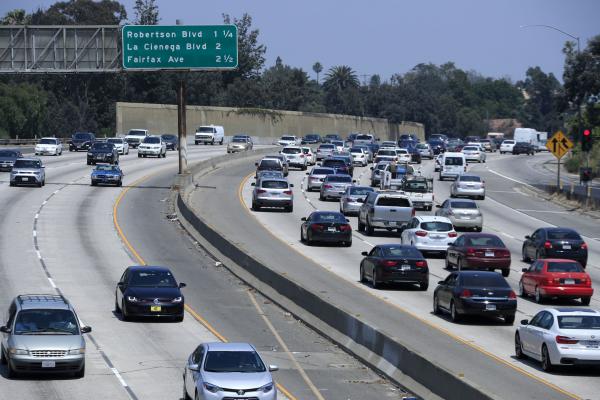
April 19 (UPI) — About 133.9 million people — roughly one-fifth of the U.S. population — live in counties with unhealthy levels of ozone or particle pollution, though the rest of the country can breathe a little easier.
The data, collected between 2014 and 2016, is part of the American Lung Association’s 2018 State of the Air report, released Wednesday. The survey ranks the most and least healthy air in states and metropolitan areas around the United States.
Although ozone pollution worsened significantly because of warmer temperatures, particulate matter, which includes dust and soot, continued to improve, ALA researchers say.
The report shows that air quality has improved significantly, despite concerns about changes to regulations at the Environmental Protection Agency.
“I will say been we’ve seen great progress in reducing air pollution,” Janice Nolen, assistant vice president of national policy at the ALA, told UPI.
Rising ozone levels a concern
The number of cars on the road in the United States continues to rise, but general pollution levels from cars have been reduced because of tougher emission standards.
“We had more days of unhealthy days for ozone. But we began to look at why and found it was the second hottest year on record,” Nolen said. “Ozone doesn’t come out of a tailgate or a smokestack, it cooks in the atmosphere.”
According to the report, 40 percent of Americans live in 185 counties that earned an F grade for ozone. And of the 10 most polluted cities, seven cities had worse air days than the previous year’s report, including Los Angeles and the New York City region.
Eight of the 10 worst areas for ozone were in California: Los Angeles-Long Beach topped the list, followed by Bakersfield, Visalia area, Fresno area, Sacramento area, San Diego, Modesto area and the Redding area.
The metro regions of New York-New Jersey-Connecticut and Pennsylvania was ninth, and the only city not on either coast was the Phoenix area — but that city has made strides, according to the report.
“With Phoenix, regulations have helped with emissions,” Nolen said.
On average, the metro area had 31.2 unhealthy days for ozone, compared to 34.7 days in the previous report.
“Oil and gas makes a difference,” Nolan said, although the city doesn’t have many smoke-inducing factories. “With the heat, it’s sitting there in sun.”
Monitoring short-term particle pollution
In terms of short-term particle pollution, 35.1 million people lived in the 53 counties with too many days when it peaked at unhealthy levels.
Bakersfield had the highest short-term particle pollution levels and was followed by the Visalia area, Calif.; Fresno area, Calif.; Fairbanks, Alaska; Modesto area, Calif.; San Jose, Calif.; Los Angeles; Salt Lake City-Provo-Urem in Utah; El Centro, Calif.; and the Pittsburgh area.
In the past, Fairbanks lacked sufficient monitoring data to provide year-round information — but this year the city has the highest year-round particle pollution, up from No. 17 in the 2017 report.
“The people of Fairbanks, Alaska, and all Americans, have the right to know if the air they are breathing is dangerous,” American Lung Association National President and CEO Harold P. Wimmerc said in a press release. “Improved monitoring is a critical step toward clean-up efforts that will save lives. Greater monitoring of air quality nationwide may also identify additional health risks in other locations in the United States.”
The cleanest cities in this year’s report, earning an A, are: Bellingham, Wash.; Burlington, Va., area; Casper, Wyoming; Honolulu; Melbourne area, Fla; and Wilmington, N.C. To qualify, they had no days of high levels of ozone or particulate matter, and were ranked among the 25 cities with the lowest year-round particle pollution levels.
Changes to air quality regulations
The report covers the years before President Donald Trump took office on Jan. 20, 2017, but experts are concerned that improvements in air quality could stall out as the administration weakens or rolls back EPA regulations.
Earlier this month, EPA Administrator Scott Pruitt determined current standards are “not appropriate and should be revised” after the midterm evaluation process for greenhouse gas emission requirements for cars and light trucks for model years 2022 through 2025. The previous administration set an average of 54.5 miles per gallon by 2025.
“The Clean Air Act has saved lives and improved lung health for nearly 50 years,” Wimmer said. “Congress and the EPA are tasked with protecting Americans — including protecting the right to breathe air that doesn’t make people sick or die prematurely. We call on President Trump, EPA Administrator Scott Pruitt and members of Congress to fully fund, implement and enforce the Clean Air Act for all pollutants — including those that drive climate change and make it harder to achieve healthy air for all.”
Importance of localized data
In unhealthy areas, children are especially vulnerable, researchers on the report say.
“One of the reasons they are at risk is that 87 percent of their lungs are developed after they are born,” Nolen said. “When kids are not in good areas, it affects development. They are at risk for lung disease.”
Nolan said the ALA often is contacted about the safest places for air quality. Because of that, the association set up a tool on its website to compare metro areas.
The association makes an effort to focus on specific regions, rather than taking a national approach.
“People don’t breath average air,” Nolen said. “A lot of people use the report to see where to live. You can compare the air by putting in the ZIP code. People want to know where to retire. Children have asthma.”
Data for the report, and for the air quality safety tool, was collected from the EPA, as well as from state and tribal sources.
Global concern about air quality
One day before the ALA report was released, the State of Global Air for 2018 was released by the Health Effects Institute, the Institute for Health Metrics and Evaluation and the University of British Columbia.
That report found that 95 percent of people live in areas where the outdoor fine particulate matter concentrations exceeds the World Health Organization’s Air Quality Guideline. And almost 60 percent of people live in areas where fine particulate matter exceeds even the least stringent WHO interim air quality target. The United States, however, was listed in the safest of five categories.
Poor air quality contributed to an estimated 6.1 million deaths across the globe in 2016, the report said, and China and India were responsible for more than 50 percent of global deaths attributable to pollution.
There is now an 11-fold gap between the most- and least-polluted areas, compared to a six-fold gap in 1990, the researchers say.
“We used to have a slogan — ‘when you can’t breathe, nothing matters,'” Nolan said. “It’s not just lung disease. People are at risk from air pollutants.”





